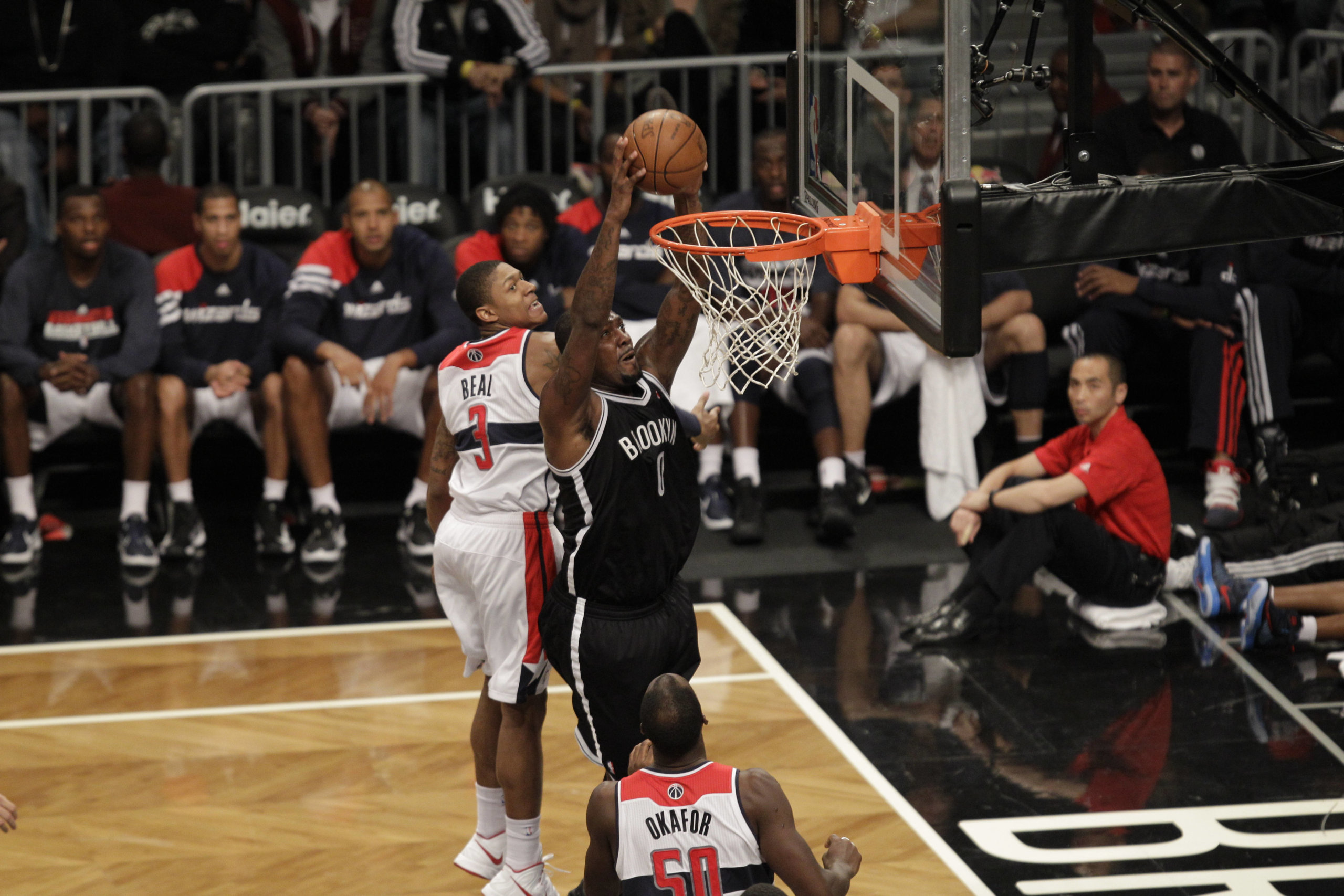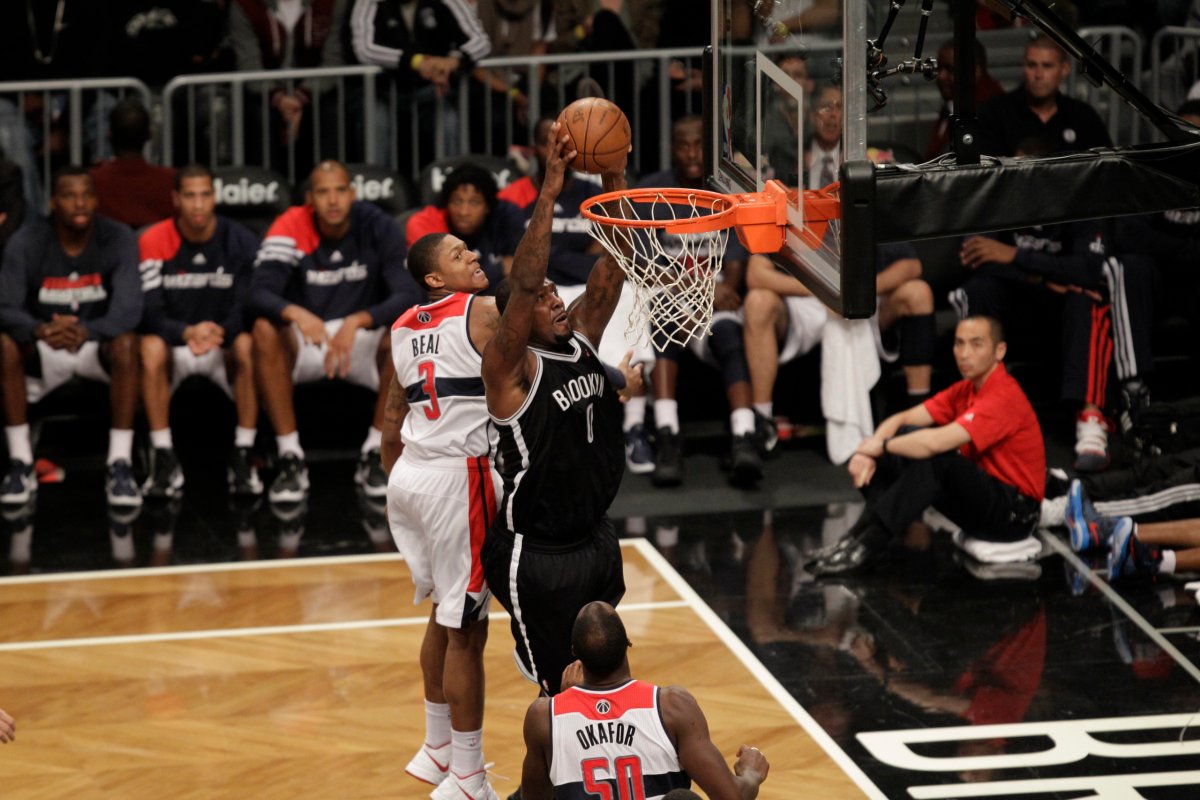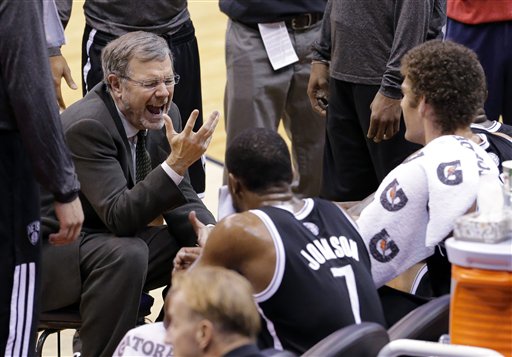
Brooklyn’s “Bench Mob” has already earned its share of attention in the early part of the season – primarily for the offensive performances from the likes of Andray Blatche, CJ Watson, MarShon Brooks and Jerry Stackhouse. But what’s most impressive in these (very) early stages of the season is how the group has performed defensively. Last night’s come-from-behind victory against the Los Angeles Clippers was a shining example when the bench kept the game even during the first few minutes of the 4th quarter and then Reggie Evans was subbed back in for the games final four minutes when the Nets outscored the Clippers 12-2.
Looking at some limited overall numbers at 82games shows Avery Johnson’s three primary “bench heavy” lineups – those consisting of at least four bench players and one starter (usually Joe Johnson) or less – demonstrates the defensive efficiency and overall success of these combinations.
The most popular bench unit – Watson/Johnson/Stackhouse/Reggie Evans/Blatche is allowing a paltry 64 points per 100 possessions in their collective 23.6 minutes of floor time, good for a +/- of +20. The second bench mob, consisting of Watson/Stackhouse/Josh Childress/Reggie Evans and Blatche, is only allowing 60 points per 100 possessions and a +/- of +10 in 12.8 minutes of floor time. The final bench package (and most sparingly used of the three thus far) is Watson/Brooks/Johnson/Evans/Blatche. In about 9 minutes of floor time, the unit has surrendered 47 points per 100 possessions.
I don’t think anyone expects these numbers to be sustainable over the course of 82 games, especially as injuries occur and everyone inevitably regresses to the mean, but these numbers do offer some insight into why the Nets are off to one of their better starts in franchise history. While the starting units have demonstrated a penchant for scoring and inconsistent defense, the Bench Mob has been able to step in and put out any potential fires from the first quarter (it could also explain why the Nets have had a habit of building up so many halftime leads with the bulk of the bench mob closing out the first half). It’s also a far cry on both ends of the floor from last year’s primary bench mob (which was harder to determine than you would think considering the number of lineups the Nets were forced to use) of Jordan Farmar/Brooks/DeShawn Stevenson/Kris Humphries/Shelden Williams, which allowed 120 points per 100 possessions (though now that I think of it, I think those five started a number of games together last year :::shudder:::)
As for sustainability – a few things to look at. For one, how good are these players defensively as individuals? Brooks’ defense has often been the butt of jokes as MarSwag looks far more interested in scoring than in shutting down the opposition, and the numbers bear that out as the team allowed 113.2 points per 100 possessions with Brooks on the court last season and 107.7 points off the court (while opposing SGs averaged a below average PER of 12.8 with Brooks on the floor and SFs above average 18.1). Blatche is another player who was never remotely known for worthwhile defense and like Brooks, the team performed better defensively with Blatche on the bench (107.1 per 100 off court/111.8 per 100 on court). Unlike Brooks, both PFs and Cs put up above average PERs with Blatche on the court (17.0 and 19.1 respectively).
Considering he came from Tom Thibodeau’s high-emphasis-on-defense system in Chicago, you would think that CJ Watson was a shutdown back-up PG, but like his fellow members of the bench mob, Watson’s on court/off court numbers last year show a struggle (103.6 per 100 on court/96.1 points per 100 off court). Opposing PGs put up a PER of 17.6 with Watson on court and opposing SGs 27.8 (yikes).
That leaves us with Evans – the crotch grabbing, rebound hawking, flop-happy de facto captain of the bench mob (sorry Godfather Blatche, but my eye test shows Evans is the energizer bunny for the second unit). Evans was brought in primarily for his toughness and defensive tenacity. There has to be some on court/off court numbers to support this, right? Nope. With the Clippers last year, the team’s defensive efficiency was 112.1 points per 100/on court with Evans and 105.8 per 100/off court. Meanwhile, opposing PFs averaged a PER of 17.1 against Evans.
So is this some long-winded way of me dashing your hopes and dreams of this Bench Mob unit ever being successful defensively over a sustained period of time? Certainly, it’s POSSIBLE that these guys (and Joe Johnson) have some crazy chemistry with each other and will find a way to at least be respectable, but part of the reason why I wanted to spill some virtual ink on this topic is because I’m just so dumbfounded by these early numbers, especially in the context of how a number of these players performed a year ago. Granted on court/off court numbers are not even close to the end all be all of defensive metrics, but it’s funny how these things can sometimes validate what you’re already seeing – in this case, “wow these guys who were a collection of castoffs and one-dimensional players a year ago are really performing above expectations and helping the Brooklyn Nets win games in the first month of the season.” Viva la Bench Mob.
















